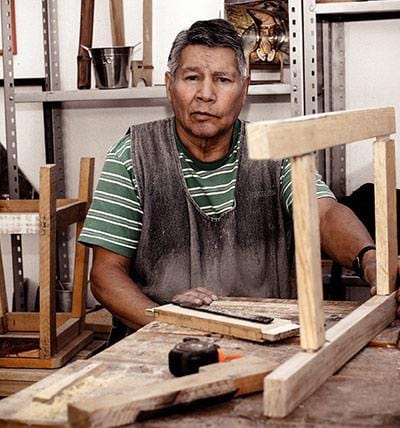Discover the secrets to arrange a stylish, cohesive open floor plan living space with our expert design tips and tricks for decorating, furniture placement, and more.
While open concept floor plans offer a blank canvas, it can also be quite devastating to imagine filling these kinds of spaces.
You don't want the room to feel empty, cold, or too big; housemodify will help you to arrange furniture in all types open floor plans.
What is An Open Floor Plan?

An open-concept floor plan is typically two or three rooms that are an open space.
This means that there are no walls or doorways separating the respective rooms.
It's all just one big, multifunctional space.
The combination of the dining room, kitchen and living room is the most popular open-concept floor plan.
Why is Furniture Layout Important in an Open Plan Area?
The way in which you arrange furniture in your open-concept space is very important and has a huge impact on the feel and overall usability of the room.
How you arrange furniture will also impact how your room feels.
Does it feel crowded and like there's too much going on?
Does it feel sparse and empty?
Does the room feel warm and inviting, or does it feel cold and like a showroom?
Finally, does the room feel like one big room? Or does it feel like a few different rooms in one?
How you decide to arrange furniture will affect whether or not your open-concept space feels cohesive.
8 Ideas to Arrange Furniture in an Open Floor Plan:
So how do you actually plan out open-concept living spaces?
Here are eight ideas:
1. Create Zones with Area Rugs:
You can use an area rug as an anchor point when arranging furniture.
An area rug is a simple way to tie a room together and make all the space seem smaller and more manageable.

2. Create a Theme:
Maintaining a cohesive interior design theme throughout the open concept space creates a cohesion as you move between areas, i.e. from the living room area to the dining space.
For example, you could settle on a modern style throughout or maybe choose accent pieces that are the same color for some visual symmetry.
But alongside your chosen design style, you can have a huge impact through the materials and textures you choose to use in your home.
Fabrics with texture will feel warmer and cozier.
3. Place Large Furniture Opposite Focal Points:
When arranging furniture in your open-concept floor plan, place your large pieces of furniture opposite any focal points in your room, for example a sofa facing a fireplace.
After you've placed your largest piece of furniture opposite the focal point, you can arrange the rest of the furniture around it.
In this open plan space, the seating is arranged around the TV and log burner.
If your open-concept living room or dining room doesn't have a focal point, you can make your own.
You could place a bookshelf and a striking piece of art and arrange your furniture around that.
By organizing your space around focal points, you may naturally create distinct zones in the space that indicate which areas are meant for lounging and which may require a little more formality.
4. Choose Practical and Flexible Furnishings:
As we discussed in point two above, you must select the exact style or atmosphere you want to establish in your room.
However, we understand that tastes and needs vary throughout time.
So, wherever possible, invest in adaptable, modular furniture to ensure you may change up your room layout at any time.
For example, a big comfortable sofa to catch the big game on a Sunday might be important to you.
But a year or two down the line, you might prefer to switch from the TV as a focal point to create more of a conversation space in your open-concept living room, so instead of one large sofa, you might want a three-seater with a couple of armchairs or a loveseat.
A modular sofa will satisfy your demands in both instances, allowing you to arrange it as you like and adjust it as your needs change.
Modular shelf units are handy for furnishing open spaces.
You can set up a small storage unit behind your sofa as a boundary between the living and dining areas.
However, if your design changes, you may add or remove components from a modular shelving unit to accommodate your needs.
5. Carefully Consider Sofa Placement:
The sofa is an essential component of any living or gathering space, thus its placement in an open-plan room is critical.
The layout of your seating area can have a big impact on how the space is used.
When placing your sofa, think about how you want the area to be used.
For example, if you want to create an environment for conversations and catch-ups, you might consider placing two sofas opposite each other.
If you're designing your living space around a huge entertainment centre for movie nights, you can go for a large sectional facing the TV.

6. Keep the furniture away from the wall:
It may be tempting to position your furniture against walls, but it is not necessarily the ideal way to approach an open-plan area.
Floating a sofa in the center of an open plan space might help to separate areas.
Having furniture further from the walls can make the open-concept living room feel bigger.
At the same time, it can create clearer divides between one space and another as well as making clear walkways between separate spaces.
7. Consider Traffic Flow:
You need to consider traffic flow in the planning stage of arranging furniture.
Your traffic flow is how easy it is to move around the space.
Open-concept areas become more difficult to navigate when they are overly packed with furnishings.
There should always be adequate space to move about comfortably.
When planning your room, pick direct paths between each space and make sure to keep furniture clear from these areas.
You also need to consider leaving enough space to open doors and windows.
It's also worth noting that you don't have to keep things the same forever.
With an open concept living room, you have the luxury of trying different layouts whenever it strikes you.
8. Use Furniture as a Buffer Between Spaces:
The sofa placement in this space helps to create a divide between living and dining areas.
Turning sofas or other large furniture away from zones such as the kitchen or dining room can serve as a buffer between spaces and aid in highlighting where the living space ends and the eating space begins.
This is a simple approach to establishing a barrier between naturally occurring zones.
ABOUT THE AUTHOR
Aleksandra Djurdjevic
Senior Content Creator
Aleksandra Djurdjevic is a senior writer and editor, covering jewelry, accessories, and trends. She’s also works with services, home décor. She has previously worked as ESL teacher for English Tochka. Aleksandra graduated from the Comparative Literature department at the Faculty of Philosophy in Serbia. Aleksandra’s love for the environment, crafts and natural products over the years helps her continue to be a top expert at Wooden Earth.






